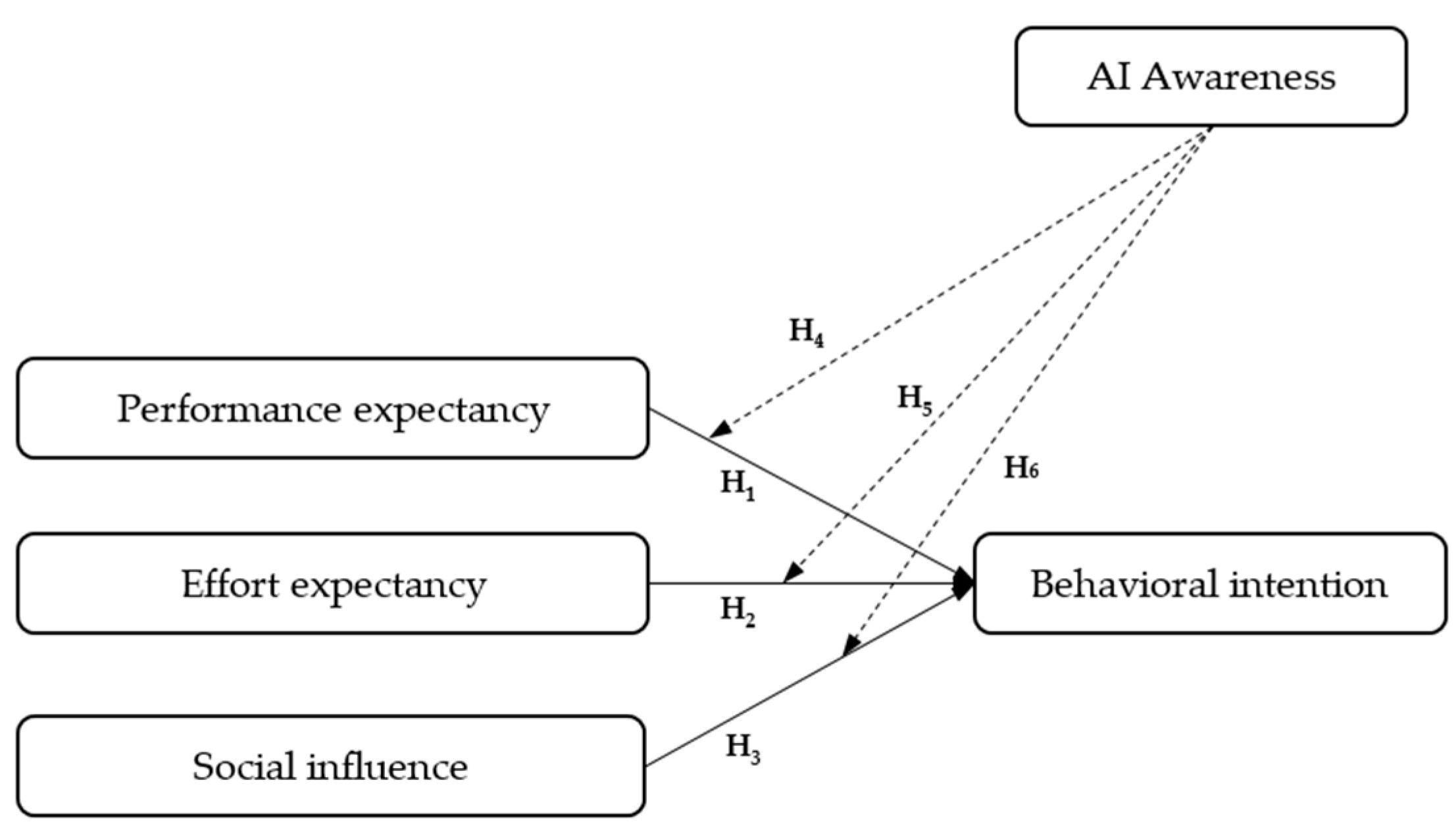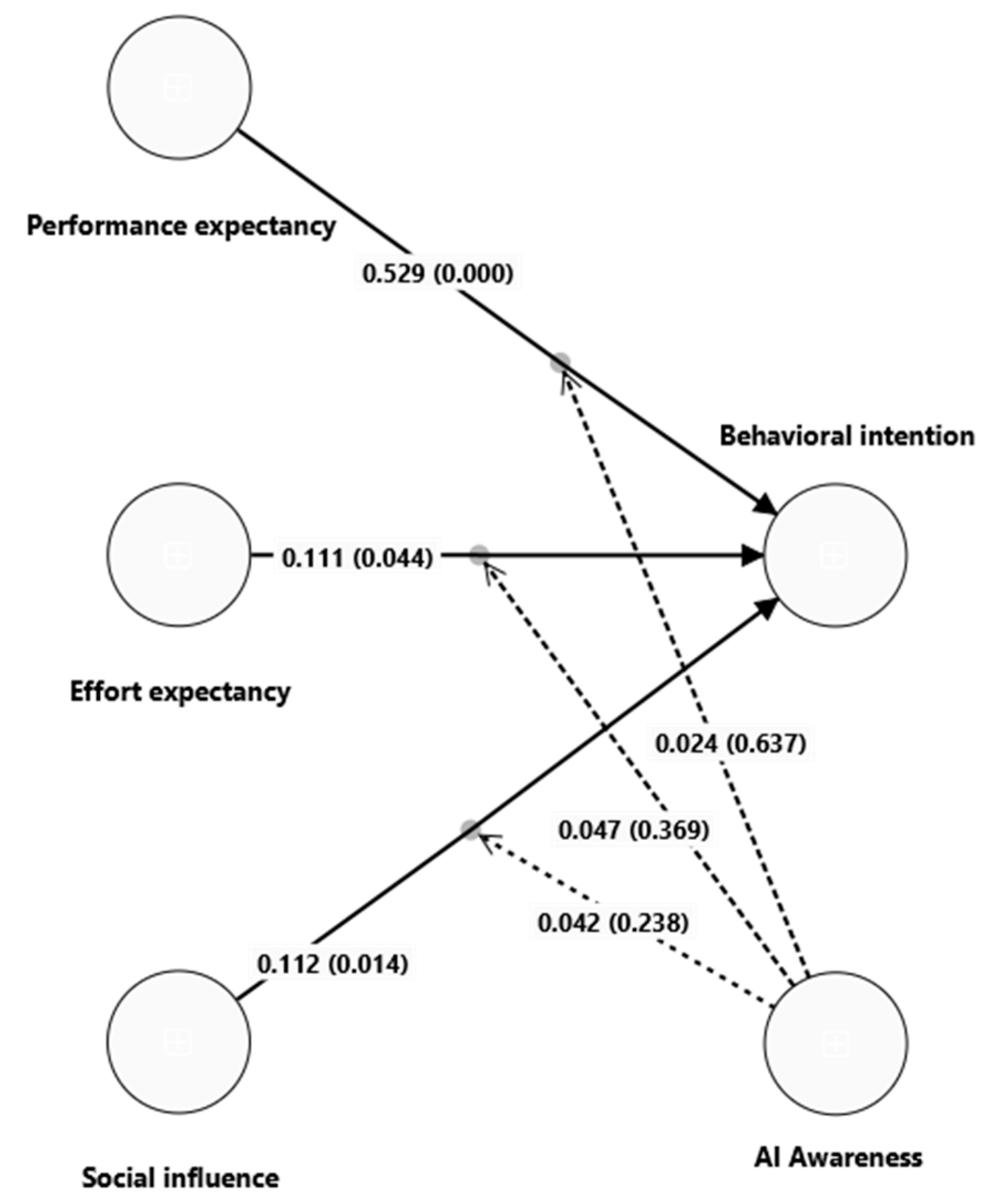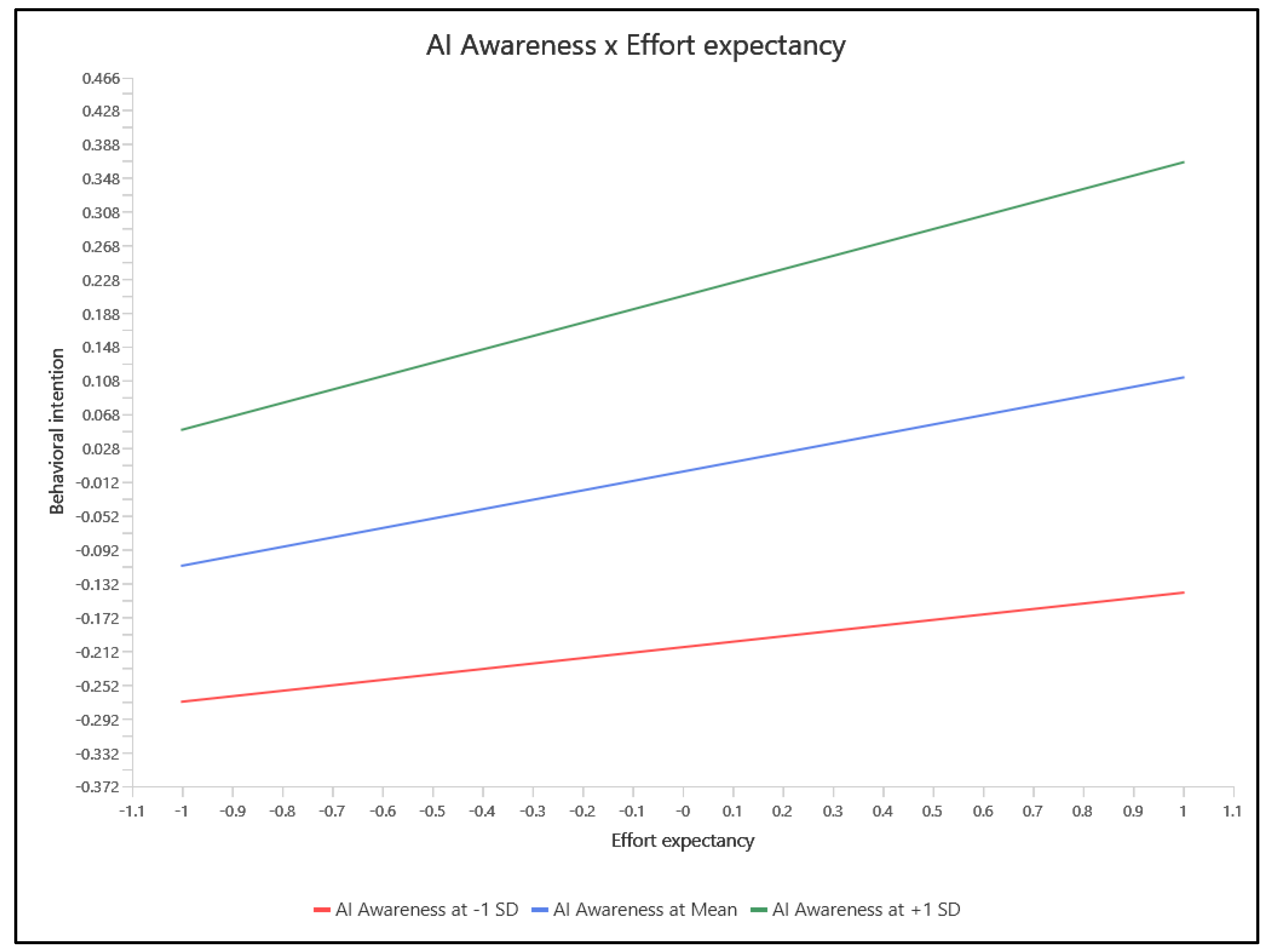Students’ Intention toward Artificial Intelligence in the Context of Digital Transformation
Abstract
1. Introduction
2. Literature Review and Hypotheses Development
2.1. Students’ Intention toward AI
2.2. Conceptual Model and Hypotheses
3. Research Methodology
- indicator reliability (by examining outer loadings),
- internal consistency reliability (by examining Cronbach’s α and composite reliability (CR)),
- convergent validity (by examining the average variance extracted (AVE)), and
- discriminant validity (by examining Fornell–Larcker and HTMT criterion).
4. Results
5. Discussion
6. Conclusions
Author Contributions
Funding
Informed Consent Statement
Data Availability Statement
Conflicts of Interest
References
- Prentice, G.; Brady, J.; McLaughlin, C. Education Service Quality, Value and Satisfaction on Student Customer Intentions and Behaviour; DBS Library Press: Dublin, Ireland, 2018. [Google Scholar]
- Chawla, M. Customers’ (students’) perceptions about 7ps of higher education marketing mix. Asian J. Multidiscip. Stud. 2013, 1, 106–112. Available online: https://core.ac.uk/download/pdf/229675328.pdf (accessed on 13 January 2024).
- Russell, M. Marketing education: A review of service quality perceptions among international students. Int. J. Contemp. Hosp. Manag. 2005, 17, 65–77. [Google Scholar] [CrossRef]
- Faranda, W.T.; Clarke, T.B.; Clarke, I., III. Marketing student perceptions of academic program quality and relationships to surface, deep, and strategic learning approaches. J. Mark. Educ. 2021, 43, 9–24. [Google Scholar] [CrossRef]
- Teo, T.; Zhou, M. Explaining the intention to use technology among university students: A structural equation modeling approach. J. Comput. High. Educ. 2014, 26, 124–142. [Google Scholar] [CrossRef]
- Kaur, N.; Gopal, K. An assessment of students’ intention of technology acceptance for online education. J. Posit. Sch. Psychol. 2022, 6, 4563–4577. Available online: https://journalppw.com/index.php/jpsp/article/view/2127 (accessed on 15 January 2024.).
- Boucher, P. Artificial Intelligence: How Does It Work, Why Does It Matter, and What Can We Do About It? In European Parliamentary Research Service; European Parliament: Brussels, Belgium, 2020; Available online: https://www.europarl.europa.eu/RegData/etudes/STUD/2020/641547/EPRS_STU(2020)641547_EN.pdf (accessed on 18 January 2024.).
- Sing, C.C.; Teo, T.; Huang, F.; Chiu, T.K.; Wei, W.X. Secondary school students’ intentions to learn AI: Testing moderation effects of readiness, social good and optimism. Educ. Technol. Res. Dev. 2022, 70, 765–782. [Google Scholar] [CrossRef]
- Klopov, I.; Shapurov, O.; Voronkova, V.; Nikitenko, V.; Oleksenko, R.; Khavina, I.; Chebakova, Y. Digital Transformation of Education Based on Artificial Intelligence. TEM J. 2023, 12, 2625–2634. [Google Scholar] [CrossRef]
- Oliveira, K.K.S.; de Souza, R.A.C. Digital transformation towards education 4.0. Inform. Educ. 2022, 21, 283–309. [Google Scholar] [CrossRef]
- McCarthy, A.M.; Maor, D.; McConney, A.; Cavanaugh, C. Digital transformation in education: Critical components for leaders of system change. Soc. Sci. Humanit. Open 2023, 8, 100479. [Google Scholar] [CrossRef]
- Quy, V.K.; Thanh, B.T.; Chehri, A.; Linh, D.M.; Tuan, D.A. AI and digital transformation in higher education: Vision and approach of a specific university in Vietnam. Sustainability 2023, 15, 11093. [Google Scholar] [CrossRef]
- Chassignol, M.; Khoroshavin, A.; Klimova, A.; Bilyatdinova, A. Artificial Intelligence trends in education: A narrative overview. Procedia Comput. Sci. 2018, 136, 16–24. [Google Scholar] [CrossRef]
- Holmes, W.; Tuomi, I. State of the art and practice in AI in education. Eur. J. Educ. 2022, 57, 542–570. [Google Scholar] [CrossRef]
- Rahiman, H.U.; Kodikal, R. Revolutionizing education: Artificial intelligence empowered learning in higher education. Cogent Educ. 2024, 11, 2293431. [Google Scholar] [CrossRef]
- Pedró, F. Artificial Intelligence in Education: Challenges and Opportunities for Sustainable Development; UNESCO Education Sector: Paris, France, 2019. [Google Scholar]
- Aggarwal, D. Green Education: A Sustainable Development Initiative with the Power of Artificial Intelligence (AI). J. Image Process. Intell. Remote Sens. 2023, 3, 39–44. [Google Scholar] [CrossRef]
- Sohn, K.; Kwon, O. Technology acceptance theories and factors influencing artificial Intelligence-based intelligent products. Telemat. Inform. 2020, 47, 101324. [Google Scholar] [CrossRef]
- Huang, Y.-C. Integrated concepts of the UTAUT and TPB in virtual reality behavioral intention. J. Retail. Consum. Serv. 2023, 70, 103127. [Google Scholar] [CrossRef]
- Kim, J.; Erdem, M.; Kim, B. Adoption of in-room voice assistants: A cross-cultural study. J. Hosp. Tour. Insights 2023. ahead-of-print. [Google Scholar] [CrossRef]
- Balakrishnan, J.; Abed, S.S.; Jones, P. The role of meta-UTAUT factors, perceived anthropomorphism, perceived intelligence, and social self-efficacy in chatbot-based services? Technol. Forecast. Soc. Chang. 2022, 180, 121629. [Google Scholar] [CrossRef]
- Menon, D.; Shilpa, K. “Chatting with ChatGPT”: Analyzing the factors influencing users’ intention to Use the Open AI’s ChatGPT using the UTAUT model. Heliyon 2023, 9, e20962. [Google Scholar] [CrossRef]
- Chatterjee, S.; Rana, N.P.; Khorana, S.; Mikalef, P.; Sharma, A. Assessing Organizational Users’ Intentions and Behavior to AI Integrated CRM Systems: A Meta-UTAUT Approach. Inf. Syst. Front. 2023, 25, 1299–1313. [Google Scholar] [CrossRef]
- Kim, Y.J.; Choi, J.H.; Fotso, G.M.N. Medical professionals’ adoption of AI-based medical devices: UTAUT model with trust mediation. J. Open Innov. Technol. Mark. Complex. 2024, 10, 100220. [Google Scholar] [CrossRef]
- Horodyski, P. Recruiter’s perception of artificial intelligence (AI)-based tools in recruitment. Comput. Hum. Behav. Rep. 2023, 10, 100298. [Google Scholar] [CrossRef]
- Tanantong, T.; Wongras, P. A UTAUT-Based Framework for Analyzing Users’ Intention to Adopt Artificial Intelligence in Human Resource Recruitment: A Case Study of Thailand. Systems 2024, 12, 28. [Google Scholar] [CrossRef]
- Andrews, J.E.; Ward, H.; Yoon, J. UTAUT as a Model for Understanding Intention to Adopt AI and Related Technologies among Librarians. J. Acad. Librariansh. 2021, 47, 102437. [Google Scholar] [CrossRef]
- Cao, G.; Duan, Y.; Edwards, J.S.; Dwivedi, Y.K. Understanding managers’ attitudes and behavioral intentions towards using artificial intelligence for organizational decision-making. Technovation 2021, 106, 102312. [Google Scholar] [CrossRef]
- Ferri, L.; Maffei, M.; Spanó, R.; Zagaria, C. Uncovering risk professionals’ intentions to use artificial intelligence: Empirical evidence from the Italian setting. Manag. Decis. 2023. ahead-of-print. [Google Scholar] [CrossRef]
- Loske, D.; Klumpp, M. Intelligent and efficient? An empirical analysis of human–AI collaboration for truck drivers in retail logistics. Int. J. Logist. Manag. 2021, 32, 1356–1383. [Google Scholar] [CrossRef]
- Chai, C.S.; Wang, X.; Xu, C. An Extended Theory of Planned Behavior for the Modelling of Chinese Secondary School Students’ Intention to Learn Artificial Intelligence. Mathematics 2020, 8, 2089. [Google Scholar] [CrossRef]
- Chai, C.S.; Chiu, T.K.; Wang, X.; Jiang, F.; Lin, X.F. Modeling Chinese Secondary School Students’ Behavioral Intentions to Learn Artificial Intelligence with the Theory of Planned Behavior and Self-Determination Theory. Sustainability 2023, 15, 605. [Google Scholar] [CrossRef]
- Ayanwale, M.A. Evidence from Lesotho Secondary Schools on Students’ Intention to Engage in Artificial Intelligence Learning. In Proceedings of the 2023 IEEE AFRICON, Nairobi, Kenya, 20–22 September 2023; pp. 1–6. [Google Scholar] [CrossRef]
- Wang, F.; King, R.B.; Chai, C.S.; Zhou, Y. University students’ intentions to learn artificial intelligence: The roles of supportive environments and expectancy–value beliefs. Int. J. Educ. Technol. High. Educ. 2023, 20, 51. [Google Scholar] [CrossRef]
- Ayanwale, M.A.; Sanusi, I.T.; Adelana, O.P.; Aruleba, K.D.; Oyelere, S.S. Teachers’ readiness and intention to teach artificial intelligence in schools. Comput. Educ. Artif. Intell. 2022, 3, 100099. [Google Scholar] [CrossRef]
- Sanusi, I.T.; Ayanwale, M.A.; Chiu, T.K.F. Investigating the moderating effects of social good and confidence on teachers’ intention to prepare school students for artificial intelligence education. Educ. Inf. Technol. 2024, 29, 273–295. [Google Scholar] [CrossRef]
- Alzahrani, L. Analyzing Students’ Attitudes and Behavior toward Artificial Intelligence Technologies in Higher Education. Int. J. Recent Technol. Eng. 2023, 11, 65–73. [Google Scholar] [CrossRef]
- Chatterjee, S.; Bhattacharjee, K.K. Adoption of artificial intelligence in higher education: A quantitative analysis using structural equation modelling. Educ. Inf. Technol. 2020, 25, 3443–3463. [Google Scholar] [CrossRef]
- Ragheb, M.A.; Tantawi, P.; Farouk, N.; Hatata, A. Investigating the acceptance of applying chat-bot (Artificial intelligence) technology among higher education students in Egypt. Int. J. High. Educ. Manag. 2022, 8, 1–13. [Google Scholar] [CrossRef]
- Wu, W.; Zhang, B.; Li, S.; Liu, H. Exploring Factors of the Willingness to Accept AI-Assisted Learning Environments: An Empirical Investigation Based on the UTAUT Model and Perceived Risk Theory. Front. Psychol. 2022, 13, 870777. [Google Scholar] [CrossRef] [PubMed]
- Romero-Rodríguez, J.M.; Ramírez-Montoya, M.S.; Buenestado-Fernández, M.; Lara-Lara, F. Use of ChatGPT at university as a tool for complex thinking: Students’ perceived usefulness. J. New Approaches Educ. Res. 2023, 12, 323–339. [Google Scholar] [CrossRef]
- Yu, S. A Research on University Students’ Behavioral Intention to use New-generation Information Technology in Intelligent Foreign Language Learning. ACM Trans. Asian Low-Resour. Lang. Inf. Process. 2022, in press. [Google Scholar] [CrossRef]
- Le Dang, H. An analysis of the factors affecting intention to use artificial intelligence technology in learning: A case study of Hanoi students. AJMI-ASEAN J. Manag. Innov. 2020, 7, 1–16. Available online: https://ajmi.stamford.edu/index.php/ajmi/article/view/183 (accessed on 13 January 2024.).
- Buabbas, A.J.; Miskin, B.; Alnaqi, A.A.; Ayed, A.K.; Shehab, A.A.; Syed-Abdul, S.; Uddin, M. Investigating Students’ Perceptions towards Artificial Intelligence in Medical Education. Healthcare 2023, 11, 1298. [Google Scholar] [CrossRef]
- Almaraz-López, C.; Almaraz-Menéndez, F.; López-Esteban, C. Comparative Study of the Attitudes and Perceptions of University Students in Business Administration and Management and in Education toward Artificial Intelligence. Educ. Sci. 2023, 13, 609. [Google Scholar] [CrossRef]
- Venkatesh, V.; Morris, M.G.; Davis, G.B.; Davis, F.D. User acceptance of information technology: Toward a unified view. MIS Q. 2003, 27, 425–478. [Google Scholar] [CrossRef]
- Collins, C.J. The interactive effects of recruitment practices and product awareness on job seekers’ employer knowledge and application behaviors. J. Appl. Psychol. 2007, 92, 180–190. [Google Scholar] [CrossRef]
- Abubakar, F.M.; Ahmad, H.B. The moderating effect of technology awareness on the relationship between UTAUT constructs and behavioural intention to use technology: A conceptual paper. Aust. J. Bus. Manag. Res. 2013, 3, 14–23. [Google Scholar] [CrossRef]
- Abubakar, F.M.; Ahmad, H.B. Empirical Investigation of Moderating Effect of Technology Awareness in UTAUT. Niger. J. Manag. Technol. Dev. 2015, 1, 109–134. [Google Scholar]
- Daniali, S.M.; Barykin, S.E.; Zendehdel, M.; Kalinina, O.V.; Kulibanova, V.V.; Teor, T.R.; Ilyina, I.A.; Alekseeva, N.S.; Lisin, A.; Moiseev, N.; et al. Exploring UTAUT Model in Mobile 4.5 G Service: Moderating Social–Economic Effects of Gender and Awareness. Soc. Sci. 2022, 11, 187. [Google Scholar] [CrossRef]
- Al-Azizi, L.; Al-Badi, A.H.; Al-Zrafi, T. Exploring the factors influencing employees’ willingness to use mobile applications in Oman: Using UTAUT model. J. E-Gov. Stud. Best Pract. 2018, 2018, 553293. Available online: https://ibimapublishing.com/articles/JEGSBP/2018/553293/553293.pdf (accessed on 19 January 2024). [CrossRef]
- Statistical Office of the Republic of Serbia. Statistical Yearbook of the Republic of Serbia; Statistical Office of the Republic of Serbia: Belgrade, Serbia, 2021. Available online: https://publikacije.stat.gov.rs/G2021/PdfE/G20212054.pdf (accessed on 19 January 2024).
- Statistical Office of the Republic of Serbia. Statistical Yearbook of the Republic of Serbia; Statistical Office of the Republic of Serbia: Belgrade, Serbia, 2022. Available online: https://publikacije.stat.gov.rs/G2022/pdf/G20222055.pdf (accessed on 19 January 2024).
- Statistical Office of the Republic of Serbia. Statistical Yearbook of the Republic of Serbia; Statistical Office of the Republic of Serbia: Belgrade, Serbia, 2023. Available online: https://publikacije.stat.gov.rs/G2023/Pdf/G20232056.pdf (accessed on 19 January 2024).
- Hair, J.F.; Hult, G.T.M.; Ringle, C.M.; Sarstedt, M. A Primer on Partial Least Squares Structural Equation Modeling; Sage: Thousand Oaks, CA, USA, 2017. [Google Scholar]
- Raub, S.; Blunschi, S. The power of meaningful work: How awareness of CSR initiatives fosters task significance and positive work outcomes in service employees. Cornell Hosp. Q. 2014, 55, 10–18. [Google Scholar] [CrossRef]
- Becker, J.-M.; Cheah, J.-H.; Gholamzade, R.; Ringle, C.M.; Sarstedt, M. PLS-SEM’s most wanted guidance. Int. J. Contemp. Hosp. Manag. 2023, 35, 321–346. [Google Scholar] [CrossRef]
- Ilić, M.P.; Păun, D.; Popović Šević, N.; Hadžić, A.; Jianu, A. Needs and Performance Analysis for Changes in Higher Education and Implementation of Artificial Intelligence, Machine Learning, and Extended Reality. Educ. Sci. 2021, 11, 568. [Google Scholar] [CrossRef]
- Kuleto, V.; Ilić, M.; Dumangiu, M.; Ranković, M.; Martins, O.M.D.; Păun, D.; Mihoreanu, L. Exploring Opportunities and Challenges of Artificial Intelligence and Machine Learning in Higher Education Institutions. Sustainability 2021, 13, 10424. [Google Scholar] [CrossRef]
- Bucea-Manea-Țoniş, R.; Kuleto, V.; Gudei, S.C.D.; Lianu, C.; Lianu, C.; Ilić, M.P.; Păun, D. Artificial Intelligence Potential in Higher Education Institutions Enhanced Learning Environment in Romania and Serbia. Sustainability 2022, 14, 5842. [Google Scholar] [CrossRef]
- Chen, X.; Xie, H.; Hwang, G.-J. A multi-perspective study on Artificial Intelligence in Education: Grants, conferences, journals, software tools, institutions, and researchers. Comput. Educ. Artif. Intell. 2020, 1, 100005. [Google Scholar]
- Foffano, F.; Scantamburlo, T.; Cortés, A. Investing in AI for social good: An analysis of European national strategies. AI Soc. 2023, 38, 479–500. [Google Scholar] [CrossRef]
- Chan, C.K.Y. A comprehensive AI policy education framework for university teaching and learning. Int. J. Educ. Technol. High. Educ. 2023, 20, 38. [Google Scholar] [CrossRef]







| Constructs and Items | Loadings | AVE | CR | Cronbach’s α |
|---|---|---|---|---|
| Performance expectancy | 0.700 | 0.921 | 0.893 | |
| PE1 | 0.841 | |||
| PE2 | 0.856 | |||
| PE3 | 0.838 | |||
| PE4 | 0.866 | |||
| PE5 | 0.780 | |||
| Effort expectancy | 0.668 | 0.909 | 0.875 | |
| EE1 | 0.783 | |||
| EE2 | 0.754 | |||
| EE3 | 0.851 | |||
| EE4 | 0.846 | |||
| EE5 | 0.846 | |||
| Social influence | 0.641 | 0.899 | 0.859 | |
| SI1 | 0.801 | |||
| SI2 | 0.729 | |||
| SI3 | 0.821 | |||
| SI4 | 0.854 | |||
| SI5 | 0.792 | |||
| Behavioral intention | 0.920 | 0.972 | 0.956 | |
| BI1 | 0.967 | |||
| BI2 | 0.971 | |||
| BI3 | 0.939 |
| BI | EE | PE | SI | |
|---|---|---|---|---|
| Behavioral intention (BI) | 0.959 | |||
| Effort expectancy (EE) | 0.569 | 0.817 | ||
| Performance expectancy (PE) | 0.694 | 0.593 | 0.837 | |
| Social influence (SI) | 0.457 | 0.379 | 0.400 | 0.800 |
| HTMT | |
|---|---|
| Effort expectancy <-> Behavioral intention | 0.620 |
| Performance expectancy <-> Behavioral intention | 0.747 |
| Performance expectancy <-> Effort expectancy | 0.665 |
| Social influence <-> Behavioral intention | 0.504 |
| Social influence <-> Effort expectancy | 0.437 |
| Social influence <-> Performance expectancy | 0.457 |
Disclaimer/Publisher’s Note: The statements, opinions and data contained in all publications are solely those of the individual author(s) and contributor(s) and not of MDPI and/or the editor(s). MDPI and/or the editor(s) disclaim responsibility for any injury to people or property resulting from any ideas, methods, instructions or products referred to in the content. |
© 2024 by the authors. Licensee MDPI, Basel, Switzerland. This article is an open access article distributed under the terms and conditions of the Creative Commons Attribution (CC BY) license (https://creativecommons.org/licenses/by/4.0/).
Share and Cite
Milicevic, N.; Kalas, B.; Djokic, N.; Malcic, B.; Djokic, I. Students’ Intention toward Artificial Intelligence in the Context of Digital Transformation. Sustainability 2024, 16, 3554. https://doi.org/10.3390/su16093554
Milicevic N, Kalas B, Djokic N, Malcic B, Djokic I. Students’ Intention toward Artificial Intelligence in the Context of Digital Transformation. Sustainability. 2024; 16(9):3554. https://doi.org/10.3390/su16093554
Chicago/Turabian StyleMilicevic, Nikola, Branimir Kalas, Nenad Djokic, Borka Malcic, and Ines Djokic. 2024. "Students’ Intention toward Artificial Intelligence in the Context of Digital Transformation" Sustainability 16, no. 9: 3554. https://doi.org/10.3390/su16093554
APA StyleMilicevic, N., Kalas, B., Djokic, N., Malcic, B., & Djokic, I. (2024). Students’ Intention toward Artificial Intelligence in the Context of Digital Transformation. Sustainability, 16(9), 3554. https://doi.org/10.3390/su16093554










